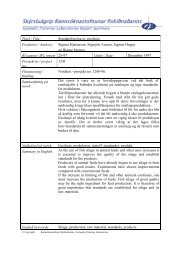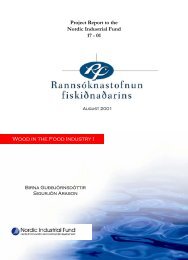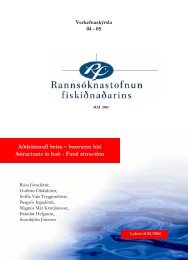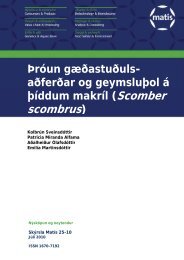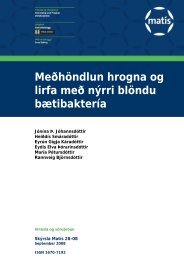Microbiology and Spoilage Trail in Nile Perch (Lates niloticus), Lake ...
Microbiology and Spoilage Trail in Nile Perch (Lates niloticus), Lake ...
Microbiology and Spoilage Trail in Nile Perch (Lates niloticus), Lake ...
You also want an ePaper? Increase the reach of your titles
YUMPU automatically turns print PDFs into web optimized ePapers that Google loves.
(around 6 log10 cfu/g) after 12 storage days regardless of the longer storage time of whole<br />
<strong>Nile</strong> perch <strong>in</strong> ice prior process<strong>in</strong>g at establishments. The long shelf life of fillets with <strong>in</strong>itial<br />
high counts of > 4 log10 cfu/g can be expla<strong>in</strong>ed by the lower psycrophilic counts <strong>in</strong><br />
tropical/fresh water fish compared to temprate water fish (Disney (1976) <strong>and</strong> Shwewan<br />
(1977).<br />
Total volatile base nitrogen changes were small <strong>and</strong> parallel with the Enterobacteriaceae<br />
counts dur<strong>in</strong>g the first 12 days of storage. The <strong>in</strong>crease <strong>in</strong> TVB-N levels depend on<br />
numbers of SSO, H2S (black colonies) produc<strong>in</strong>g bacteria i.e. Aeromonas <strong>and</strong> Shewanella<br />
(Gram et al., 1990). Likewise Enterobacteriaceae <strong>and</strong> non H2S (white colonies) produc<strong>in</strong>g<br />
bacteria which <strong>in</strong>clude Pseudomonas, Alcaligens, Moraxella, <strong>and</strong> Ac<strong>in</strong>etobacter can also<br />
produce TVB-N (Gram et al., 1987). In all spoilage micro flora <strong>and</strong> chemical changes were<br />
rapid after 12 days of storage. This means bacterial activity <strong>in</strong> the fish flesh leads to<br />
accumulation of TVB-N. The TVB-N content <strong>in</strong>clude TMA which is produced by bacteria<br />
when they are at higher numbers i.e. ≥ 10 8 -10 9 cfu/g (Chytiri et al., 2004; Rehbe<strong>in</strong> <strong>and</strong><br />
Oehbe<strong>in</strong>schlager, 1982).<br />
5.3.2.2 Establishment E2 (17 days iced whole <strong>Nile</strong> perch)<br />
Estimated storage life for the fillets based on the spoilage microbiological (SSO <strong>and</strong> TVC)<br />
counts is 8 days. This br<strong>in</strong>gs <strong>in</strong>to attention that <strong>Nile</strong> perch fillets that are aimed to be stored<br />
for a long time i.e. (>10 days) should be processed from a fish stored <strong>in</strong> ice for a maximum<br />
of 10-14 days. In Establishment E2 the whole fish had been stored <strong>in</strong> ice for 17 days prior<br />
to process<strong>in</strong>g. Here the fillets showed a spontaneously log phase from the beg<strong>in</strong>n<strong>in</strong>g of<br />
storage to the end with highest counts up to > 10 log10 cfu/g which has rarely been reported.<br />
The ICMSF, (1980b), reported four stages of fresh fish when stored <strong>in</strong> ice (table 4). At<br />
stage IV (> 14 storage days <strong>in</strong> ice) microbiological counts may reach ≥ 10 8 cfu/cm 2 <strong>and</strong><br />
rema<strong>in</strong> constant dur<strong>in</strong>g the rema<strong>in</strong><strong>in</strong>g storage time. The same was observed <strong>in</strong> the present<br />
work <strong>and</strong> also <strong>in</strong> a study by Gram et al., (1989). Although super chill<strong>in</strong>g treatment may<br />
have arrested or killed most of the microbial load there are still many which have survived<br />
<strong>and</strong> can account for the fast multiplication to levels beyond 10 log10 cfu/g with<strong>in</strong> 2 weeks of<br />
storage. This period (2 weeks) is declared by processors as the maximum shelf life/storage<br />
time for chilled fillets. However, it is important to fulfill the markets/ consumers<br />
requirements with respect to set shelf life as well as means of transportation <strong>and</strong> storage<br />
66




